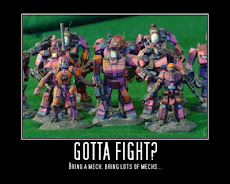It has been quite some time since I posted anything about my Too Fat Lardies games Through the Mud and the Blood WW1 project, which I started in a fit of enthusiasm, but then I lost sight of the models, and as a result progress ground to a halt. As a metaphor for WW1 this is very fitting. Well, except that in this case "lost sight" was only in the sense that they were sitting on the shelf waiting to be painted and I did nothing with them. Well Saturday I was inspired to get them out and start working on them again (I know I was distracted from working on my Spirit of Steiner force, but as I have said before, I'm like a butterfly who flutters from one thing to the next).
I realised that I wasn't totally happy with the way my British Tommies had turned out, as I had tonally transposed the uniform and webbing colours. So I set about rectifying this by an application of Games Workshop's Thraka green wash that did a good job of correcting this problem. However, while that corrected the uniform I still had to repaint the webbing. I've started on this used Catachan green for the dark tone, and will probably use a light khaki for the highlight on the webbing.
Of course once I started repainting the core of my first company I just had to look at the remaining infantry and work out what figures I needed to complete the formation. Fortunately, I had actually bought most of the necessary figures some time ago, but I had just slipped them into a shoebox until such time as I felt ready to continue painting up my British force again. Another out of sight, out of mind moment. Anyway the above picture shows the core of the four platoons my British company will have, the actual formation will be organised as follows:
Four Section Platoon
Seven man rifle section
Seven man rifle grenade section
Seven man bomber section
Ten man Lewis gun section with two Lewis guns
A Lieutenant and senior Sergeant lead the platoon
I intend to field four platoons and as you can see from the picture, add a mortar and HMG sections, with an artillery battery for support. Additional forces will include a troop of cavalry, some Whippet tanks, and of course the iconic MkIV and MkV tanks.
If my Tommies were a little unloved, my Germans were languishing even more from a lack of attention. So I got my notebook out and started sorting out the figures to complete my late war German company.
The company will consist of five platoons, or zugs as they were called by the Germans. Being this is a late war force I'm basing my formation on one that is cited in Too Fat Lardies games Through the Mud and the Blood rules.
The company will consist of three kampfzuge (battle groups), each with two zugs. The first and second kampfzuge will each have two zugs consisting of two 11 man einhets gruppes (standard squads), while the third kampfzuge will have two 16 man einhets gruppe.
Zug with two 11 man einhets gruppes
Seven man rifle squad
Four man squad with one LMG
A korporal schaften will command
Zug with two 16 man einhets gruppes
Eight man rifle squad
Eight man squad with two LMGs
A korporal schaften will command
Supporting the kampfzuge will be three squads of stossgruppe (stormtroopers). Two squads will have eight riflemen, while one squad will have ten men with two LMGs. As I like vehicles and want tanks for the Germans too, I will also add an assault stossgruppe consisting of one eight man bomber squad and an eight man pioneer squad with two, two man flame thrower teams to support the AFV7 and other captured tanks I intend to field when using this force in the offensive role.
Compared to the British company organisation, the German force just did my head in as I worked through it. Probably down to the names and the fact that the organisation was left to local commanders discression, which results in very mission orientated task organisation, but by the late war the Germans were struggling to hold the line, so it all looks a little ad hoc.
Another thing I've noticed is that the organisations here are very telling about the psychology of the factions and the inherent prejudices that both had about what made for good operational doctrine. Ultimately wars are won through logistics, not tactics and WW1 was a good predictor of the outcome for WW2, though that is largely down to 20:20 hindsight on my part.










.png)




